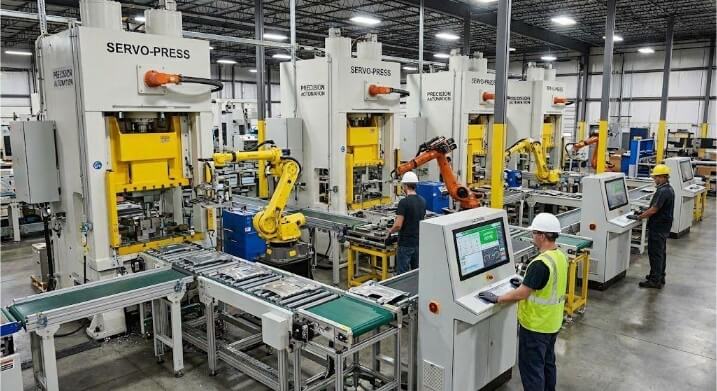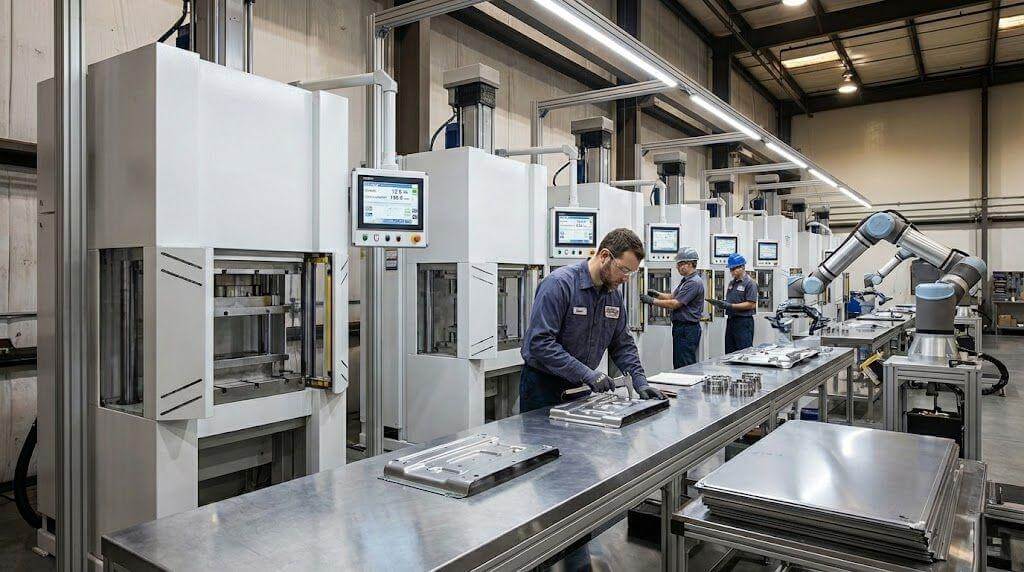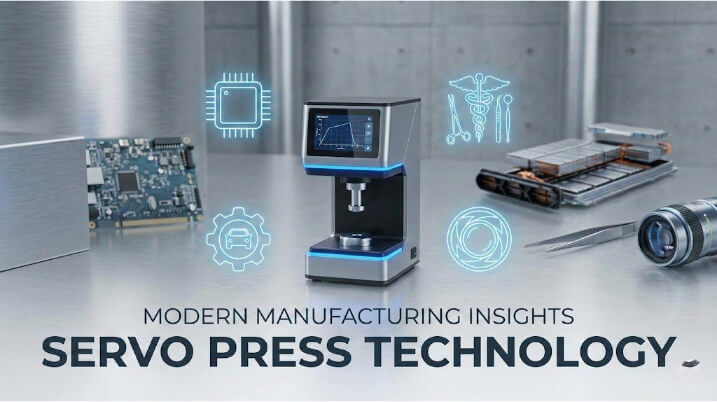Sheet metal welding combines precision, skill, and proper technique. Many fabricators struggle with warping, poor penetration, and weak joints – issues that cost time and money. With the right approach, these challenges become manageable, leading to strong, clean welds every time.
This guide covers everything from basic practices to advanced techniques, helping both newcomers and seasoned welders improve their skills. Whether you’re working on a prototype or managing production runs, these insights will enhance your welding capabilities.
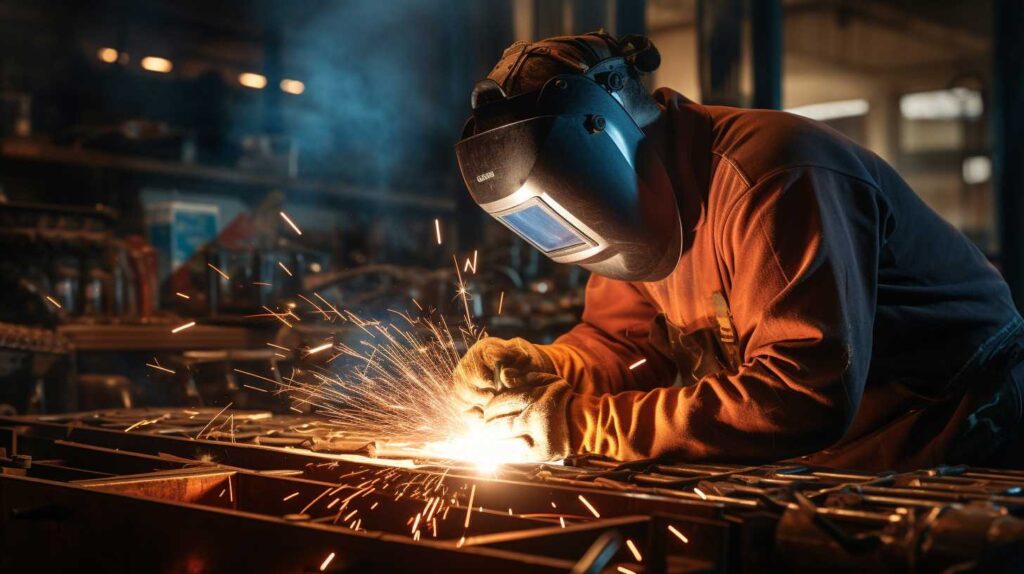
What is Sheet Metal Welding?
Sheet metal welding is the process of joining two or more thin metal sheets by applying heat, pressure, or both. The metal surfaces are heated to their melting point, and a filler material may be used to create a strong, durable bond.
This technique is widely used in industries like automotive, aerospace, and construction to create durable and permanent connections. Common methods include TIG, MIG, and spot welding, each tailored for specific materials and applications.
Why is Sheet Metal Welding Important?
Sheet metal welding ensures strong structural bonds that can withstand mechanical stress and environmental factors. It supports efficient production by reducing assembly time and costs while maintaining high-quality results.
Types of Welding for Sheet Metal
Choosing the right welding method is crucial for achieving strong, clean welds in sheet metal. Let’s explore the unique advantages, limitations, and applications of each technique in detail.
MIG Welding for Sheet Metal
MIG welding stands as one of the most widely used processes in sheet metal fabrication. The process uses a wire fed through a gun while shielding gas protects the weld pool from contamination.
Advantages of MIG Welding
MIG welding excels at producing fast, clean welds on sheet metal. The continuous wire feed creates smooth beads while maintaining consistent penetration depth.
The process requires less operator skill compared to TIG welding. A properly set up MIG welder can help even newer welders achieve good results on sheet metal projects.
Disadvantages of MIG Welding
The main drawback of MIG welding comes from its sensitivity to outdoor conditions. Wind can blow away the shielding gas, leading to poor weld quality and porosity.
Equipment costs run higher than stick welding setups. The wire feed mechanism needs regular maintenance to prevent wire feeding issues that can halt production.
TIG Welding for Sheet Metal
TIG welding represents the gold standard for precision sheet metal work. The process uses a tungsten electrode to create an arc while the welder manually feeds filler rod into the weld pool.
Key Benefits of TIG Welding
TIG welding provides unmatched control over heat input and weld pool formation. This precise control prevents warping and burn-through on thin materials.
The process creates clean, attractive welds that often need no finishing work. For visible welds on architectural or high-end products, TIG welding delivers superior aesthetic results.
Stick Welding for Sheet Metal
Stick welding uses a flux-coated electrode to create the weld. While not optimal for sheet metal, it serves specific purposes in certain situations.
Pros and Cons of Stick Welding
The main advantage of stick welding lies in its simplicity and portability. The equipment needs no gas cylinders and works well in outdoor conditions.
The downsides become apparent when working with thin materials. High heat input makes burn-through likely, and the process requires significant skill to produce good results on sheet metal.
Spot Welding for Sheet Metal
Spot welding creates welds through electrical resistance heating at specific points. This highly specialized process serves mass production environments well.
How Spot Welding Works
Two copper electrodes squeeze the metal sheets together. Electric current passing through the contact point generates heat through resistance, creating a molten nugget.
The process completes in seconds, making it ideal for automation. Modern spot welding systems can produce hundreds of welds per minute with consistent quality.
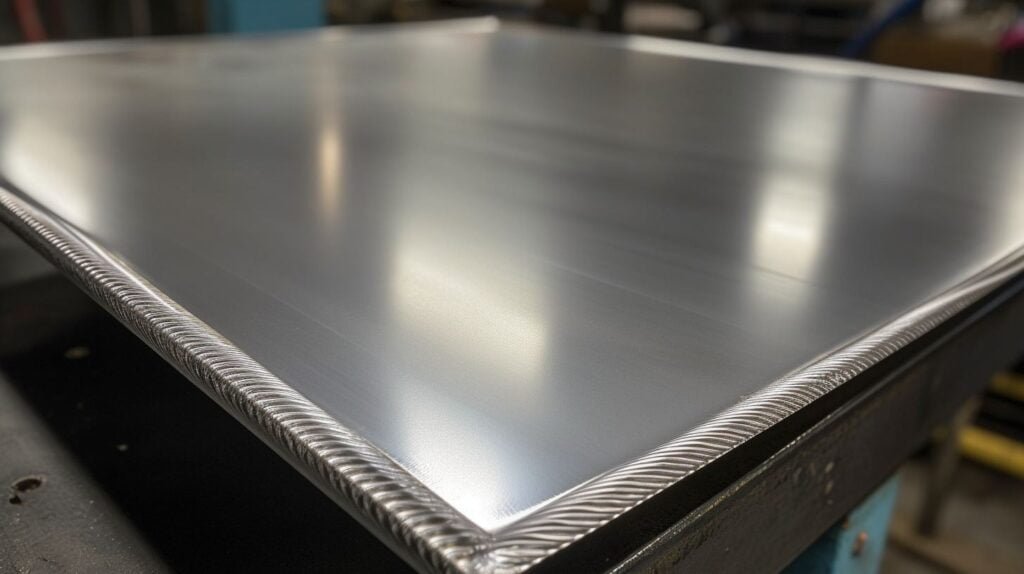
How to Weld Sheet Metal? Step-by-Step
Welding sheet metal requires precision and proper preparation. Here’s a concise step-by-step guide to help you get started:
Step 1: Prepare Your Workspace
Set up a clean, ventilated workspace free of flammable materials.
Step 2: Clean the Metal Surface
Thoroughly clean the sheet metal to remove dirt, grease, and rust. Use a degreaser or solvent for grease and a wire brush or grinder for rust and oxidation.
Step 3: Secure the Workpiece
Use clamps or fixtures to hold the sheet metal firmly in place. Align the pieces properly to ensure a straight joint.
Step 4: Choose the Right Welding Method
Select the welding method that suits your project. Adjust your equipment settings based on the chosen method and material thickness, and test on scrap material to confirm accuracy.
Step 5: Weld the Joint
Start welding by striking an arc at the beginning of the joint. Maintain a steady torch angle (10–15 degrees) and consistent movement along the joint. Control heat input carefully to avoid burn-through or distortion, especially with thin sheet metal.
Step 6: Inspect and Finish the Weld
Examine your welds for defects like cracks, porosity, or uneven beads. If necessary, grind or polish the welds to achieve a smooth finish.
Choosing the Right Welding Method for Your Project
The success of your sheet metal project depends heavily on selecting the optimal welding method. Just as a chef picks specific knives for different cutting tasks, welders must match their welding process to the job requirements.
Factors to Consider Before Choosing a Welding Method
Your welding method choice shapes the entire fabrication process. Each factor affects not just the weld quality, but also production speed, costs, and final product performance.
Thickness of Sheet Metal
The thickness of the sheet metal is a critical factor in selecting the appropriate welding method. Thin metals are prone to warping or burn-through, making techniques like TIG or MIG welding more suitable due to their precise heat control.
For thicker materials, stick welding or flux-cored arc welding may be better options as they provide deeper penetration and higher heat input.
Type of Metal Being Welded
Different metals require different welding techniques based on their properties. For instance, TIG welding is ideal for aluminum and stainless steel due to its precision and ability to handle non-ferrous metals. MIG welding works well with mild steel and thicker materials, while stick welding is versatile for a variety of metals, even those with surface contaminants like rust or paint.
Desired Weld Strength and Durability
Structural applications require full penetration welds with consistent strength throughout the joint. TIG welding creates the strongest welds but takes more time. MIG welding offers good strength with faster production speeds.
Non-structural components allow for faster processes like spot welding. The key lies in matching weld strength to the product’s service requirements without overbuilding.
How to Select the Appropriate Welding Equipment
Proper equipment selection impacts both weld quality and operator efficiency. Modern welding machines offer various features that can improve results on sheet metal.
- MIG Welding: Best for beginners and general-purpose tasks; it’s fast, efficient, and works well on thin to medium-thickness metals. However, it requires clean surfaces and shielding gas, limiting its use outdoors.
- TIG Welding: Ideal for precision work on thin metals like aluminum or stainless steel; it produces clean, high-quality welds but requires advanced skill and is slower than other methods.
- Stick Welding: Suitable for heavy-duty applications and outdoor work; it’s cost-effective and works on dirty or rusty materials but produces more spatter and requires post-weld cleanup.
Conclusion
Sheet metal welding requires skill, patience, and proper technique to achieve professional results. By following the right preparation steps, choosing appropriate methods, and practicing proper techniques, you can create strong, durable welds.
Ready to Start Your Sheet Metal Project? Our experienced team can help bring your sheet metal project to life. Contact us today for a free quote and project consultation. Our engineers will review your specifications and provide tailored solutions for your manufacturing needs.
Hey, I'm Kevin Lee

For the past 10 years, I’ve been immersed in various forms of sheet metal fabrication, sharing cool insights here from my experiences across diverse workshops.
Get in touch

Kevin Lee
I have over ten years of professional experience in sheet metal fabrication, specializing in laser cutting, bending, welding, and surface treatment techniques. As the Technical Director at Shengen, I am committed to solving complex manufacturing challenges and driving innovation and quality in each project.

